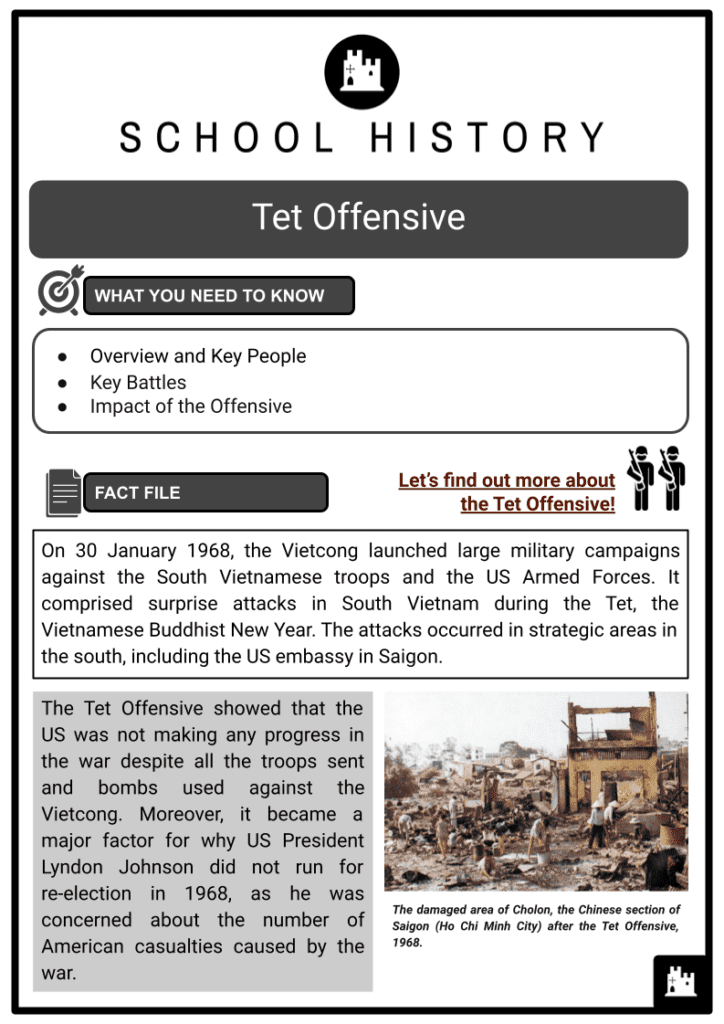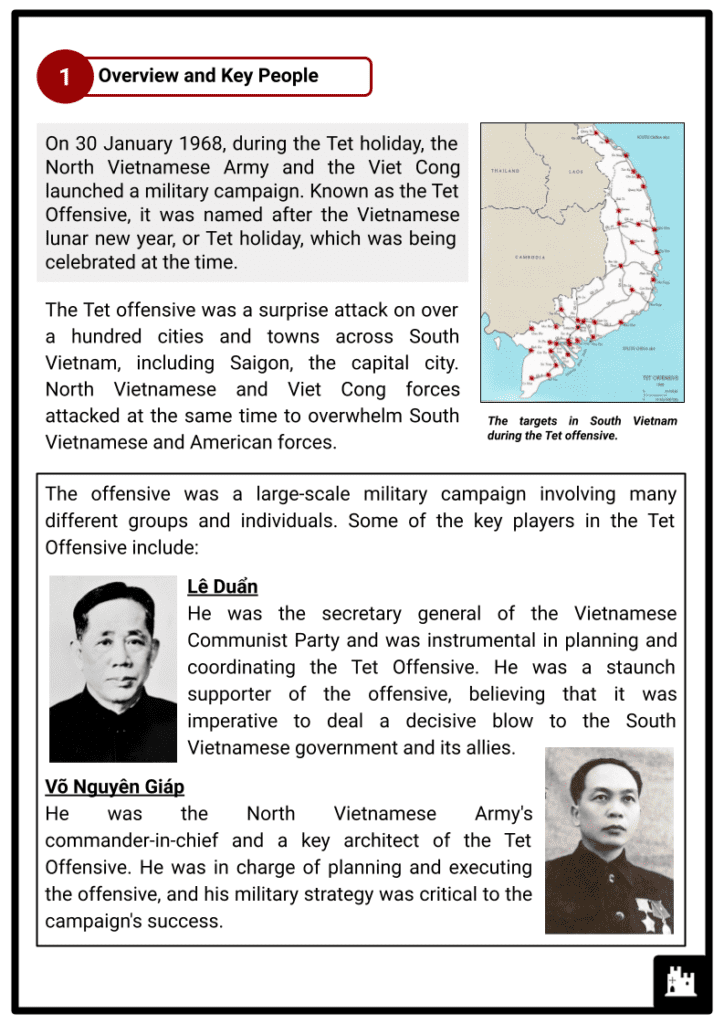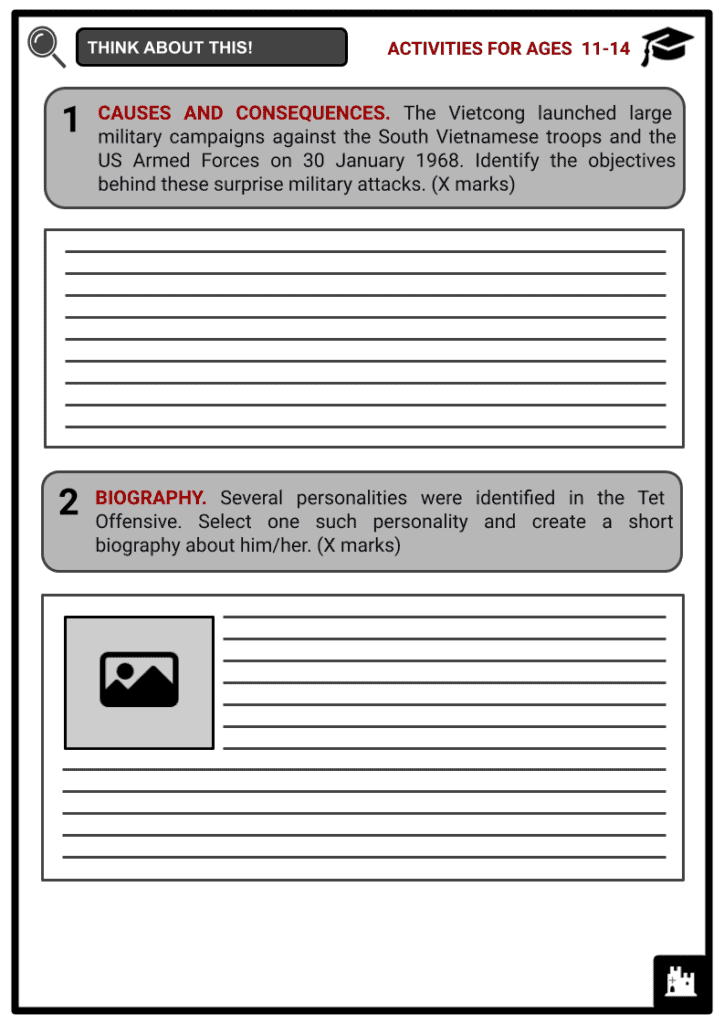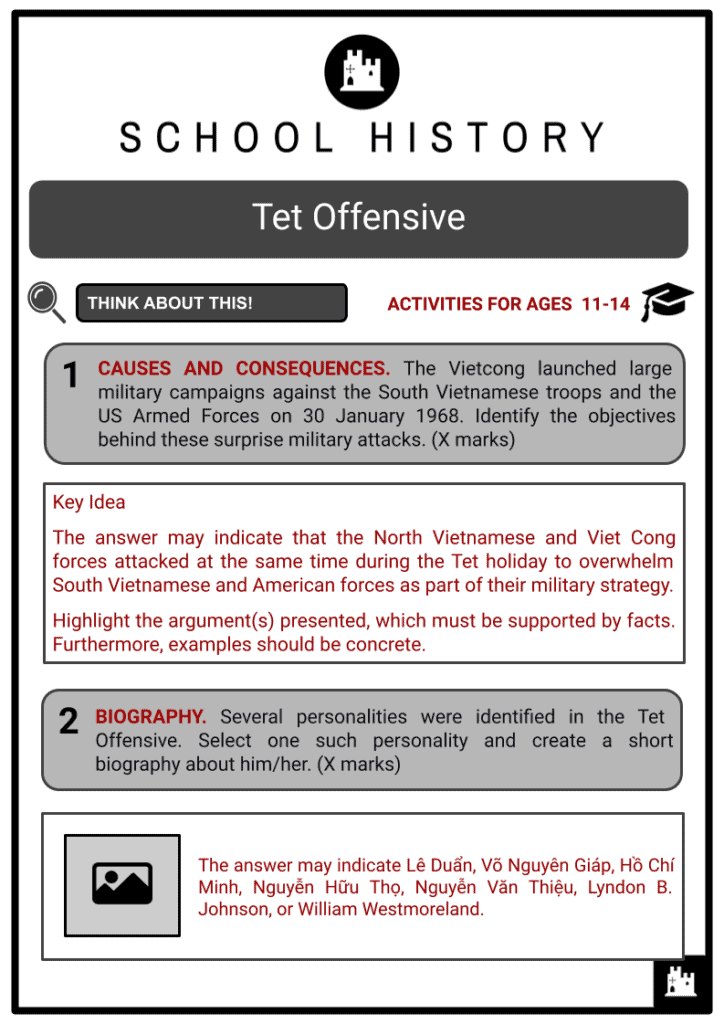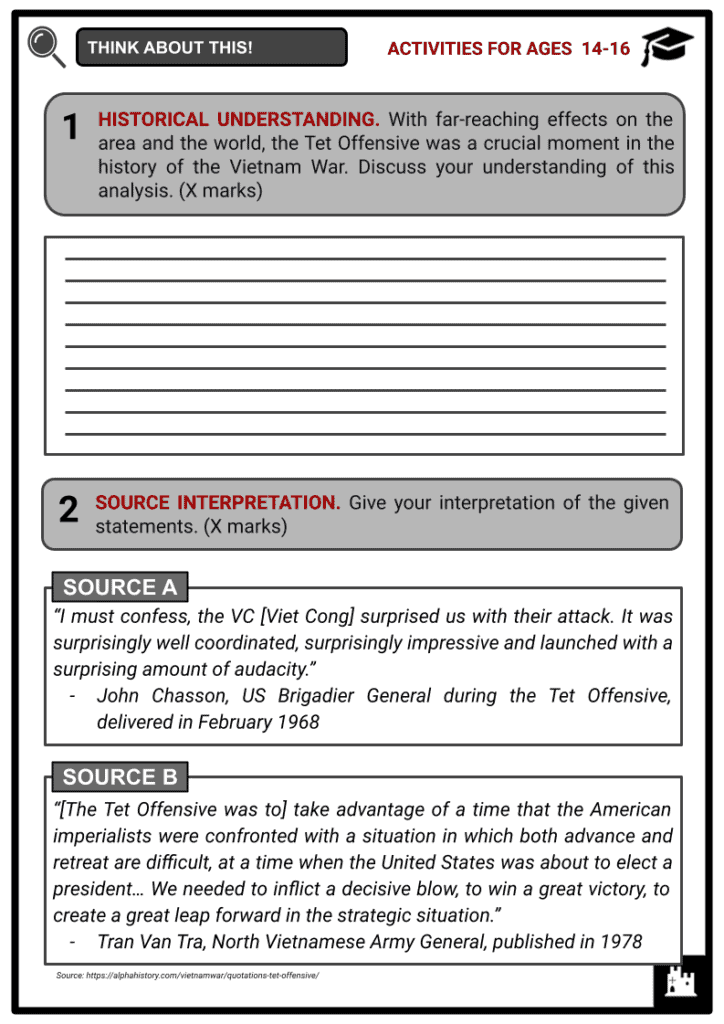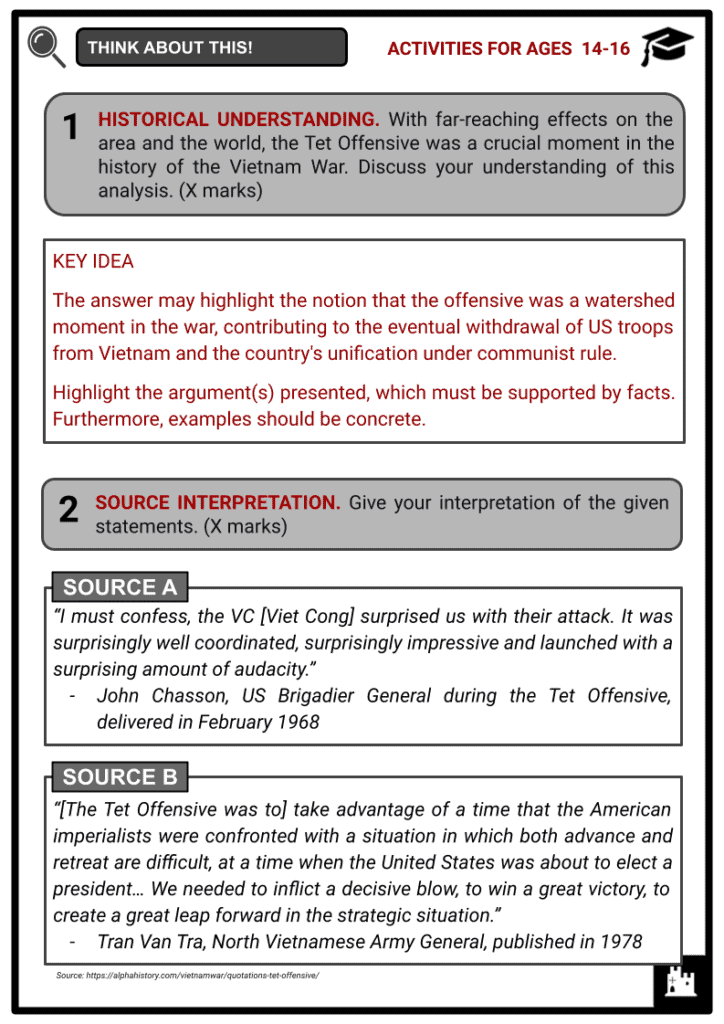Tet Offensive Worksheets
Do you want to save dozens of hours in time? Get your evenings and weekends back? Be able to teach about the Tet Offensive to your students?
Our worksheet bundle includes a fact file and printable worksheets and student activities. Perfect for both the classroom and homeschooling!
Summary
- Overview and Key People
- Key Battles
- Impact of the Offensive
Key Facts And Information
Let’s find out more about the Tet Offensive!
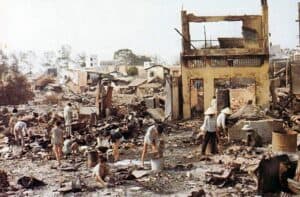
On 30 January 1968, the Vietcong launched large military campaigns against the South Vietnamese troops and the US Armed Forces. It comprised surprise attacks in South Vietnam during the Tet, the Vietnamese Buddhist New Year. The attacks occurred in strategic areas in the south, including the US embassy in Saigon. The Tet Offensive showed that the US was not making any progress in the war despite all the troops sent and bombs used against the Vietcong. Moreover, it became a major factor for why US President Lyndon Johnson did not run for re-election in 1968, as he was concerned about the number of American casualties caused by the war.
Overview and Key People
- On 30 January 1968, during the Tet holiday, the North Vietnamese Army and the Viet Cong launched a military campaign. Known as the Tet Offensive, it was named after the Vietnamese lunar new year, or Tet holiday, which was being celebrated at the time. The Tet offensive was a surprise attack on over a hundred cities and towns across South Vietnam, including Saigon, the capital city. North Vietnamese and Viet Cong forces attacked at the same time to overwhelm South Vietnamese and American forces.
The offensive was a large-scale military campaign involving many different groups and individuals. Some of the key players in the Tet Offensive include:
Lê Duẩn
- He was the secretary general of the Vietnamese Communist Party and was instrumental in planning and coordinating the Tet Offensive. He was a staunch supporter of the offensive, believing that it was imperative to deal a decisive blow to the South Vietnamese government and its allies.
Võ Nguyên Giáp
- He was the North Vietnamese Army's commander-in-chief and a key architect of the Tet Offensive. He was in charge of planning and executing the offensive, and his military strategy was critical to the campaign's success.
Hồ Chí Minh
- When the Viet Cong and the North Vietnamese Army launched the Tet Offensive, Ho Chi Minh played a crucial symbolic role. He was widely recognised as the head of the Vietnamese Communist movement and the public face of the North Vietnamese government, despite the fact that he was not actively involved in the planning or execution of the offensive. As a result, his public remarks and deeds throughout the offensive significantly affected how the Vietnamese people and the rest of the world felt about the Viet Cong and the North Vietnamese Army.
- On the eve of the Tet Offensive, Ho Chi Minh gave a well-known radio speech in which he urged the Vietnamese people to stand up and fight against the "American imperialists" and their "puppet" government in South Vietnam. His speech aided in gaining support for the offensive and boosted the morale of the North Vietnamese and Viet Cong soldiers.
- With the start of the Tet Offensive, Ho Chi Minh gave a number of speeches and public appearances to express his support for the attack and to rally the Vietnamese people to fight alongside him. Moreover, he made a statement urging the US to end the war and pull out of Vietnam.
Nguyễn Hữu Thọ
- He was the chairman of South Vietnam's National Liberation Front (NLF) and was instrumental in coordinating the offensive. He was in charge of mobilising and coordinating NLF attacks on key targets throughout South Vietnam.
Nguyễn Văn Thiệu
- During the Tet Offensive, he was the President of South Vietnam. He was in charge of overseeing the South Vietnamese government and military, and he was instrumental in coordinating the response to the offensive.
Lyndon B. Johnson
- He was the President of the United States during the Tet Offensive. He was in charge of setting US policy in Vietnam and was chastised for his handling of the war, including his decision to escalate US involvement.
William Westmoreland
- He was the commander of US forces in Vietnam during the Tet Offensive. He was in charge of overseeing American military strategy and was widely chastised for underestimating the strength and resilience of the North Vietnamese Army and the Viet Cong.
Essentially, the Tet Offensive was a complicated military operation involving many different organisations and people, all of whom were instrumental in determining how the conflict would develop. It was also considered a watershed moment in the Vietnam War, demonstrating that the North Vietnamese Army and Viet Cong were still capable of launching large-scale attacks despite American government claims that the war was nearing its end. The offensive also influenced public opinion in the United States, with many citizens questioning the government's handling of the war.
Key Events
The Tet Offensive included a series of battles across South Vietnam, with the following being some of the major battles:
Battle of Hue
- The Battle of Hue was one of the biggest and most important battles of the Tet Offensive. North Vietnamese and Viet Cong forces launched a surprise attack on Hue, South Vietnam's cultural and intellectual centre. The battle lasted more than three weeks, and North Vietnamese and Viet Cong forces eventually took control of the city, which was then retaken by American and South Vietnamese troops.
- It claimed the lives of an estimated 5,000 to 10,000 people. Many were civilians caught in the crossfire or killed by North Vietnamese and Viet Cong forces for allegedly supporting the South Vietnamese government.
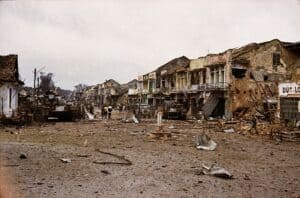
Skyhawks attacking Phuong Dinh bridge in North Vietnam, 1967
Battle of Saigon
- The Viet Cong launched a series of attacks against various targets in Saigon, including the US Embassy, during the Battle of Saigon. The attacks were intended to destabilise the South Vietnamese government and spark a general uprising, but they were ultimately unsuccessful.
- On the first day of the offensive, a group of Viet Cong fighters attacked the US Embassy in Saigon, South Vietnam's capital. Although the attackers were unable to breach the embassy compound, the attack shocked many Americans and demonstrated that even the heavily fortified US Embassy could be attacked.
Battles in the Mekong Delta
- The Tet Offensive included a series of battles in South Vietnam's Mekong Delta region, where North Vietnamese and Viet Cong forces attempted to seize key cities and towns. The Battle of Ben Tre, the Battle of Can Tho, and the Battle of Rach Kien were among these battles.
Battle of Khe Sanh
- The Tet Offensive's Battle of Khe Sanh was another significant engagement. The struggle between North Vietnamese soldiers and US Marines at Khe Sanh in northern South Vietnam raged for several months. The North Vietnamese eventually withdrew after the US Marines held the base despite being vastly outnumbered.
- Not just Hue and the Mekong Delta were affected by the Tet Offensive. In addition, Viet Cong and North Vietnamese forces attacked other cities and towns around the nation, including Da Nang, Nha Trang, and Can Tho.
- Because of the widespread warfare and lengthy duration of the Tet Offensive, it is difficult to estimate the number of fatalities. Yet, it's estimated that tens of thousands of people died during the onslaught, including soldiers, civilians, and guerrillas.
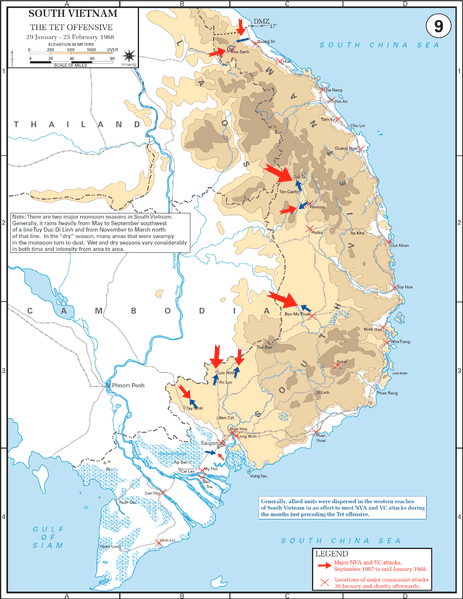
A map featuring the areas targeted during the Tet Offensive.
Significance and Impact
- The Tet Offensive was a watershed moment in the Vietnam War because it demonstrated the Viet Cong and North Vietnamese Army's strength and tenacity, forcing the US to reconsider its military strategy.
- The Tet Offensive had a significant political impact in the United States, fueling growing anti-war sentiment and undermining public support for President Lyndon B. Johnson's administration. The offensive fueled mounting calls for a cease-fire and was seen as a failure of US policy in Vietnam.
Military strategy
- The Tet Offensive demonstrated the effectiveness of guerrilla tactics and forced the US to take a more defensive stance in the conflict, leaving an indelible mark on military strategy. The offensive also aided in the development of new counterinsurgency strategies and tactics.
Destruction of Infrastructures
- During the Tet Offensive, Viet Cong and North Vietnamese soldiers attacked more than 100 towns and cities throughout South Vietnam. Significant damage was done to the infrastructure, other structures, and buildings as a result of the strikes. Civilians were forced to flee their homes and seek refuge elsewhere. According to some estimates, the offensive displaced nearly a million people.
- The Tet Offensive had a significant impact on Vietnamese citizens in both the north and south of the country. The offensive exacerbated social unrest and political instability while causing widespread devastation and displacement. The offensive also aided in the eventual unification of Vietnam under communist rule, as well as in rallying support for the communist cause in that country.
Destruction of cultural and historical sites
- Temples, monuments, and other buildings were among the cultural and historical treasures that were damaged in many of the cities and villages targeted during the Tet Offensive. The conflict frequently caused damage to or destruction of these locations.
- Moreover, the battles of the Tet Offensive significantly harmed the environment, destroying farming, forests, and other natural resources.
Casualties
- During the Tet Offensive, tens of thousands of people, including civilians, troops, and guerrilla fighters, were killed, resulting in a massive loss of life. According to the US military, the Tet Offensive claimed the lives of almost 2,500 American soldiers while also injuring thousands more.
- According to some estimates, up to 20,000 South Vietnamese soldiers may have been killed or wounded, adding to the South Vietnamese military's heavy losses. As assessed, there were roughly 50,000 casualties overall, but other estimates place the number closer to 100,000.
- Overall, the Tet Offensive was a pivotal event in the history of the Vietnam War, with far-reaching consequences for the region and the world. The offensive was a watershed moment in the war, contributing to the eventual withdrawal of US troops from Vietnam and the country's unification under communist rule.

